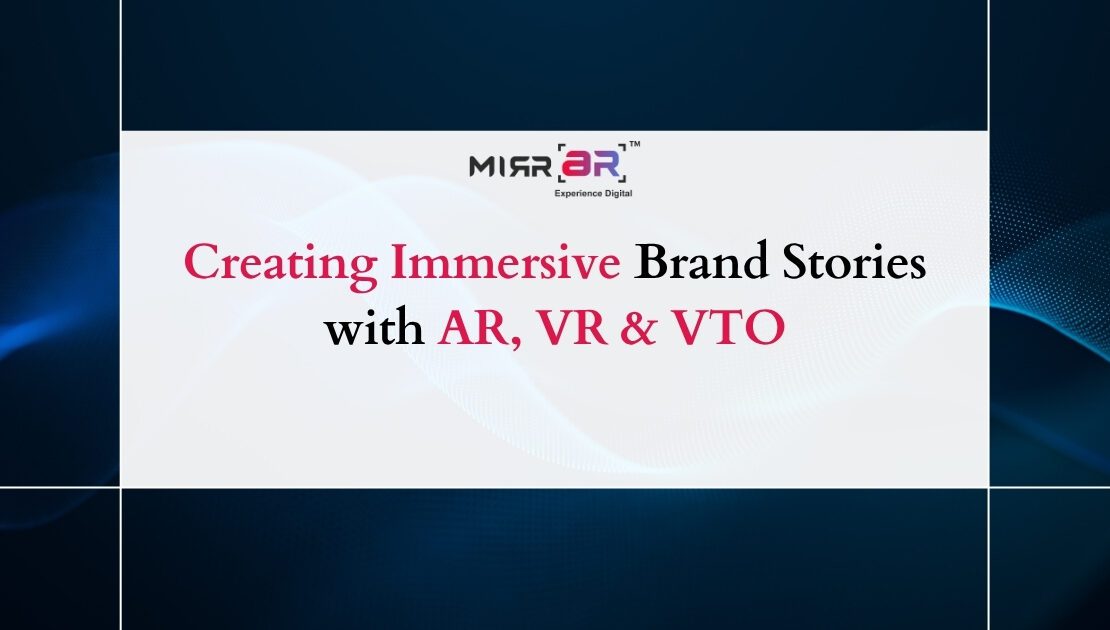
In today’s digital-first world, brands are no longer just selling products — they’re crafting experiences. As consumer expectations evolve, so does the need for storytelling that’s not only memorable but also deeply engaging. Augmented Reality (AR), Virtual Reality (VR), and Virtual Try-On (VTO) technologies are redefining the way brands connect with their audience — turning passive viewers into active participants in their brand narrative.
The Shift from Static to Immersive Storytelling
Traditional brand storytelling — through television, print, or even social media — relies on one-way communication. The consumer watches, listens, and absorbs. But immersive technologies break that wall. AR, VR, and VTO introduce a dynamic, two-way interaction. The user becomes part of the story.
For example, instead of just seeing a model wear a designer outfit, AR lets users try it on themselves in real-time through their phones. VR places them in a 360-degree virtual fashion show or a backstage design studio. And VTO allows customers to explore how a piece of clothing, makeup, or jewelry looks on them — making them co-creators of their shopping journey.
This shift builds deeper emotional connections, enhancing brand recall and customer satisfaction.
Augmented Reality: Enhancing Real-World Experiences
AR overlays digital information on the physical world. In branding, it has become a tool for storytelling that adds a new layer of interaction.
Cosmetics brands like L’Oréal allow users to scan a product and instantly see tutorials or before-and-after transformations. Furniture retailers like IKEA use AR to let users visualize how a sofa or bed will look in their living room. These aren’t just product showcases — they’re narrative experiences that place the consumer at the center of the story.
In fashion, AR can turn a billboard into a virtual runway. A scan triggers a 3D model that walks, spins, and poses — creating intrigue and encouraging social sharing. This not only drives awareness but also builds brand personality and engagement.
Virtual Reality: A New Dimension of Storytelling
VR goes a step further — immersing users in fully digital environments. In a VR-powered experience, brands can transport consumers anywhere — a Parisian fashion show, a remote textile village in India, or a luxury boutique in Milan — all from their living room.
Fashion houses are using VR to create exclusive virtual showrooms and events. Imagine putting on a headset and being welcomed into a private session with a designer, walking through their inspiration, materials, and design process. This depth of immersion fosters trust, transparency, and emotional investment.
VR is also reshaping retail spaces. Brands can create interactive, fully explorable stores that replicate the feel of in-person shopping — offering a digital alternative without losing the charm of physical spaces.
Virtual Try-On: Making the Brand Personal
VTO bridges the gap between AR and user personalization. It brings the emotional power of trying something on — without touching it physically.
For fashion, accessories, and cosmetics brands, VTO allows customers to experience the product in context — on their body, in their style, in their space. Whether it’s a lipstick shade, a saree, or a pair of sunglasses, the consumer gets to play, experiment, and personalize.
More than just a convenience, VTO is a storytelling tool. A brand isn’t just selling a red dress; it’s showing how that red dress transforms you for date night, work meetings, or brunch with friends. This contextual engagement builds emotional resonance, guiding users through their journey with the product.
Building Trust Through Immersive Technology
Trust is the currency of modern commerce. And immersive technologies help build it by offering transparency, clarity, and emotional validation.
When a customer sees exactly how a product fits or looks in real-time (thanks to VTO), their likelihood of return drops, and their confidence in the brand rises. AR-powered labels showing supply chain transparency or VR tours of ethical manufacturing facilities can also strengthen consumer trust in a brand’s values.
By allowing users to see, feel, and experience before they buy, brands reduce the cognitive gap — that space of doubt between consideration and purchase. Immersive storytelling closes that gap by making the product feel real and the brand feel human.
The Future: Connected, Creative, and Consumer-Led
As AR, VR, and VTO continue to evolve, we are entering an era where every brand becomes an experience — interactive, emotional, and personalized.
Startups and legacy brands alike are embracing these tools to offer “phygital” (physical + digital) experiences. Whether it’s a VR-powered brand documentary, an AR-led gamified campaign, or a VTO-integrated shopping experience, the future is immersive.
The competitive edge now lies not just in what a brand offers, but how it tells its story — how it brings the customer along for the ride.
Final Thoughts
Creating immersive brand stories with AR, VR, and VTO is more than a trend — it’s a transformation. It enables brands to go beyond traditional marketing and deliver experiences that are memorable, shareable, and emotionally compelling.
For businesses looking to stand out, connect deeper, and turn engagement into conversion, the message is clear: don’t just tell your brand story — let your customers live it.
